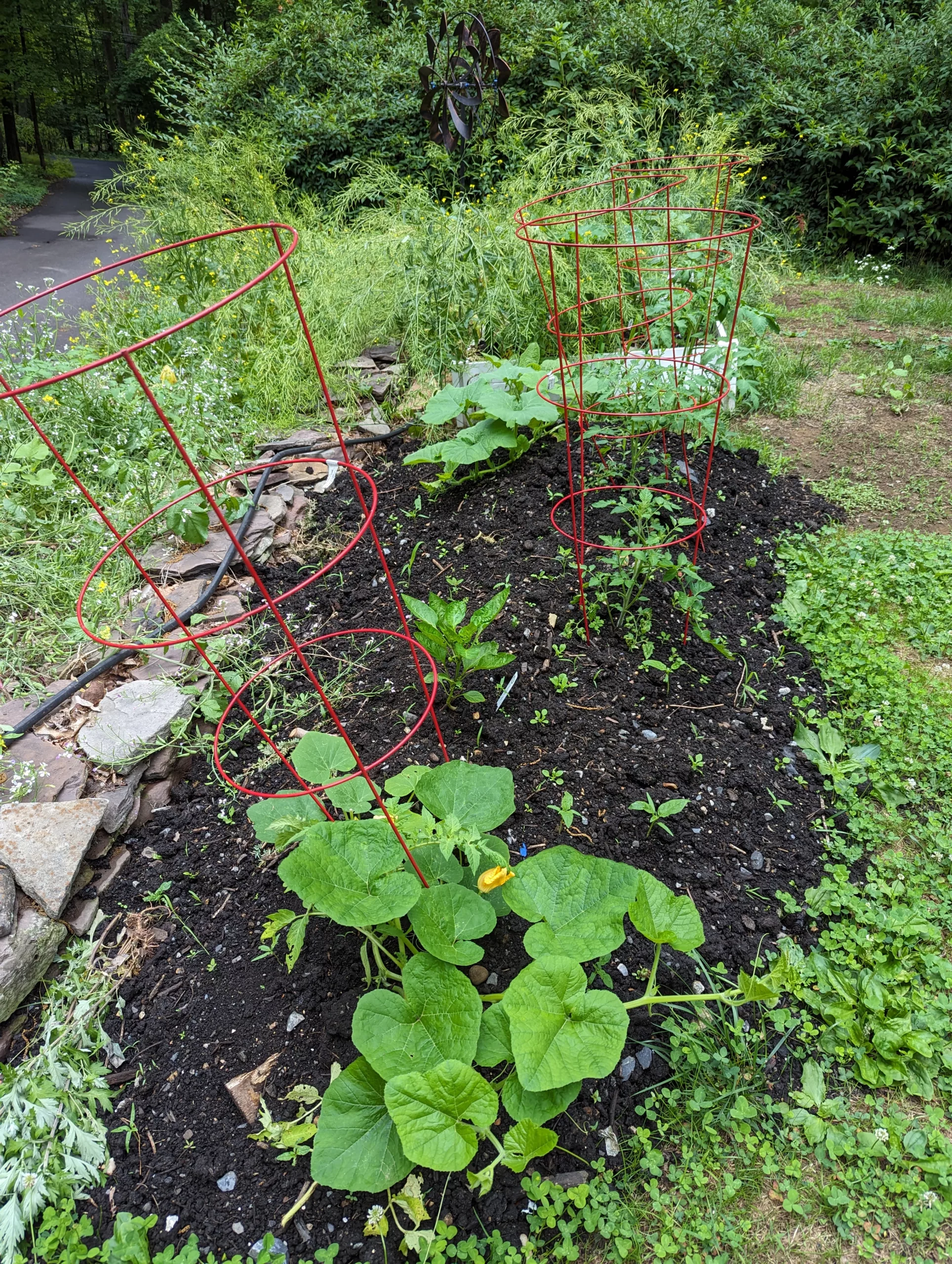Hügelkultur in Pennsylvania: Nature’s Raised Bed
Years ago, hurricane Sandy turned my forested property into an open meadow with massive rotting tree stumps everywhere. The trees on my property that used to provide shade and beauty, now produced a steady supply of fallen branches, logs, and leaves. Since I had already been slowly ‘rewilding‘ my lawn area, it seemed only natural to consider a gardening technique that turned this “debris” into a gold mine of fertility: Hügelkultur.
What is Hügelkultur?
Hügelkultur, pronounced “hoo-gul-kultur,” translates to “mound culture” or “hill culture.” It’s a centuries-old gardening method that involves creating raised garden beds by mounding logs, branches, leaves, compost, and soil. Think of it as a lasagna garden, but with a woody base layer. This base layer is the key to Hügelkultur’s many benefits.
Why Hügelkultur is a Win-Win for Your Garden
Hügelkultur provides many benefits. As long as you have the ingredients on hand, the only real drawback I can think of is that many people don’t like the way the mounds look. I’ll assume that this isn’t an issue for you and just dive right into why Hügelkultur is a win-win for your garden.
-
Waste Reduction and Recycling: Hügelkultur is an excellent way to repurpose organic materials that would otherwise end up in a landfill or burn pile. You’re essentially recycling your yard waste into rich, fertile soil. This is also way to reuse the spent substrate from my mycology hobby.
-
Improved Soil Structure: The decomposing wood acts like a sponge, absorbing water and releasing it slowly to plants. This makes Hügelkultur beds incredibly drought-resistant and perfect for our sometimes unpredictable Pennsylvania weather.
-
Increased Fertility: As the wood breaks down, it creates a nutrient-rich environment for plants. This slow-release fertilizer eliminates the need for synthetic inputs, leading to healthier and more productive gardens.
-
Warm Beds: The decomposition process generates heat, creating a microclimate that can extend your growing season. This is especially beneficial in Southeastern PA, where our spring and fall seasons can be fickle.
-
Habitat for Beneficial Organisms: The complex environment of a Hügelkultur bed provides shelter and food for a wide range of beneficial organisms, from earthworms to microbes. These creatures contribute to the overall health of your soil and garden.
Hügelkultur in Pennsylvania
Southeastern Pennsylvania is uniquely suited to Hügelkultur for several reasons:
-
Abundance of Woody Material: The deciduous forests of southeastern PA provide ample materials for building Hügelkultur beds. Oak, maple, hickory, and other hardwood species are excellent choices for the base layer.
-
Climate: Our moderate temperatures and ample rainfall provide ideal conditions for the decomposition process within the bed.
-
Soil Types: While our soils vary, Hügelkultur can be adapted to most conditions. In heavier clay soils, the mounded structure improves drainage. In sandier soils, the woody material helps retain moisture.
Building Your Hügelkultur Bed
Here’s a simplified guide to getting started:
-
Choose a Location: Select a sunny or partially shaded spot with good drainage.
-
Create a Base: Lay down logs and branches, the larger the better. Cover with smaller branches, twigs, and leaves.
-
Add Layers: Layer on compost, manure, and topsoil, building a mound.
-
Plant: Hügelkultur beds are ideal for a wide variety of plants, from vegetables and herbs to perennials and shrubs. Experiment to see what thrives in your mound.
Important Considerations:
-
Wood Choice: Avoid using black walnut, as it contains juglone, a chemical that can inhibit the growth of some plants. Treated lumber should also be avoided due to potential chemical leaching. Stick to untreated hardwood like oak, maple, or hickory for the best results.
-
Patience: The decomposition process in a Hügelkultur bed takes time. The full benefits, like improved soil structure and nutrient release, may not be realized for a few years. Be patient, and enjoy the journey as your mound matures.
-
Maintenance: While Hügelkultur beds are relatively low-maintenance, they do require some attention. Monitor moisture levels, especially in the first few years, as the woody material absorbs water. Top dress with compost or mulch annually to replenish nutrients. This is a great place to dump the soil from your container garden when the season is over.
-
Plant Selection: Choose plants that thrive in well-drained soil and can tolerate the heat generated by the decomposing wood. Some good options for southeastern PA include tomatoes, peppers, squash, beans, herbs, and perennials like lavender and coneflower.
-
Scale: Start small if you’re new to Hügelkultur. A smaller bed is easier to manage and allows you to experiment with different materials and techniques. As you gain experience, you can expand or create additional beds.
Your Journey to Hügelkultur in Pennsylvania (and everywhere!)
Hügelkultur is an exciting way to transform your landscape and gardening practices. It is more than just a gardening technique; it’s a philosophy of working with nature to create a sustainable and abundant garden. By embracing this ancient technique, you’re not only creating a fertile oasis for plants but also contributing to leading a more eco-conscious way of life.
If you’re ready to embark on your Hügelkultur journey, I encourage you to take the first step. Experiment, learn, and adapt this method to your specific needs and environment. And remember, you’re not alone!
I’d love to hear about your Hügelkultur experiences, successes, and challenges. Feel free to share your questions, photos, or insights in the comments below. Together, we can create a thriving community of Hügelkultur enthusiasts in Southeastern Pennsylvania!


Leave a Reply